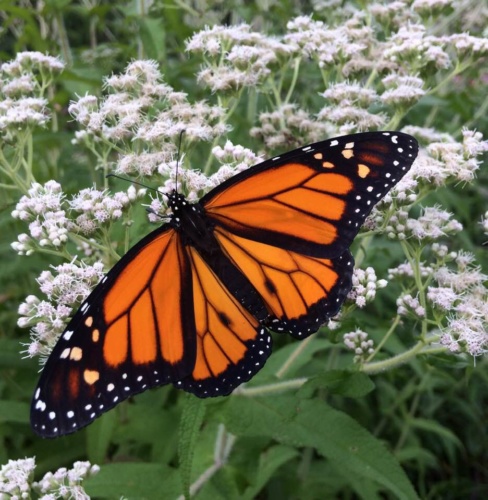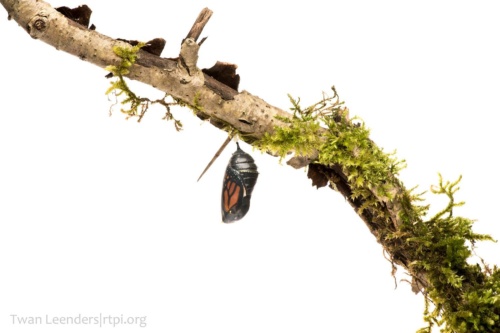Nature and her creatures are suffering, and they’re calling for our help. The message of the monarchs (Danaus plexippus), a once widespread and iconic organism now threatened with extinction, is but one of many species in unprecedented decline, pleading for our attention and action. Monarchs have much to teach us, and the plight of this amazing and ancient organism is a warning to us all that an ecological Armageddon may be underway.

The eastern monarch’s mind-boggling three thousand-mile multigenerational migration between Mexico and North America is unlike any other in the world. On their springtime journey north, adult butterflies forage on wildflowers for nectar, find mates, and exclusively seek milkweed on which to lay their eggs. They live only a few weeks. Spring migration continues northward through successive generations, each critically seeking milkweed for egg-laying and foraging on nectar flowers as summer days unfold. By early fall the final generation will undergo a marvelous and still-mysterious transformation, postponing mating until the following spring, and preparing their tiny bodies for the long migration south to their winter home. It is these great-great-grandchildren who somehow find their way back to the oyamel fir forests of Mexico, often to the exact same trees, from which their grandparents overwintered and departed the previous spring. Scientists believe these astounding migrations have been occurring for thousands of years. How these tiny creatures are able to travel so far, and how they find their ancestral overwintering sites are poorly understood.

According to the Xerces Society and Center for Biological Diversity, monarch populations have plummeted by 90% over the past two decades due to landscape-wide threats from pesticides, habitat loss, severe weather events, and climate change. The UN’s landmark IPBES Global Assessment Report on Biodiversity and Ecosystem Services warns that the web of life is unraveling. According to the IPBES chair, Sir Robert Watson, “The health of ecosystems on which we and all other species depend is deteriorating more rapidly than ever. We are eroding the very foundations of our economies, livelihoods, food security, health and quality of life worldwide…” While the monarch’s decline is a harbinger of environmental stress, thousands of other creatures are silently disappearing as well, many still unknown and unnamed. According to the IUCN’s Red List, more than 40% of amphibians, 33% of reef corals, 14% of birds, 25% of mammals, 34% of conifers, and 51% of the known freshwater fishes are threatened with extinction. Of the more than 8 million animal and plant species on Earth, of which 5.5 million are insects, 1 million are threatened with extinction within decades. A global “insect apocalypse” is already underway, in which insect abundance has declined 45% in the last 40 years, and forty percent of all insect species now face extinction. More than a third of the Earth’s terrestrial habitat integrity has been lost or degraded, while 85% of wetlands are no more.

And that brings us back to our beloved monarchs, the milkweeds and wildflowers upon which they critically depend, and the fabric of Life’s web of which they are an ancient part. Without milkweeds to exclusively provide monarch caterpillars their only food source from egg to caterpillar to chrysalis, monarch butterflies simply cannot survive. Our region’s milkweeds, including the common milkweed (Asclepias syriaca), swamp milkweed (A. incarnata), and butterfly weed (A. tuberosa), are amazingly complex and beautiful plants best known for their intoxicating fragrance, warty green pods, delicately-plumed wind-borne seeds, and critical role in the life cycle of the magnificent monarch butterfly. Tragically, populations of both native milkweeds and monarchs are in precipitous decline across the nation. Extensive herbicide use in glyphosate-tolerant (“Roundup-Ready®”) corn and soybean fields and along roadsides decimates both native nectar plants where adults feed and the precious milkweed upon which they lay their eggs, and other persistent neonicotinoid insecticides indiscriminately poison young caterpillars. Aggressive and poorly timed mowing, expanded development, logging at over-wintering sites, and generalized habitat degradation additionally contribute to catastrophic losses, while climate change threatens to disrupt the essential synching of migration to springtime and the blossoming of milkweed and other wildflowers. According to MonarchWatch.org, at least 100 million acres of milkweed and monarch habitat have been lost in the last decade due to the adoption of glyphosate-tolerant crops, while an additional 6000 acres are lost to development each DAY (2.2 million acres per year) within the butterfly’s summer breeding grounds. The North American monarch population is now considered critically imperiled.

So how can we help? Planting milkweed gardens, protecting existing milkweed habitat and propagating and restoring native wildflowers are key to the survival of this much beloved butterfly. Educate others. Don’t use pesticides. Consider raising monarchs and creating a monarch waystation in your own backyard (http://monarchwatch.org/waystations/), and explore the many monarch conservation opportunities described on the National Wildlife Federation’s website and others. Locally, please support the conservation of our area’s wetlands and other wild places, restore native habitat, and allow the natural world a place to be. We need your help, and together, we can make a difference.












